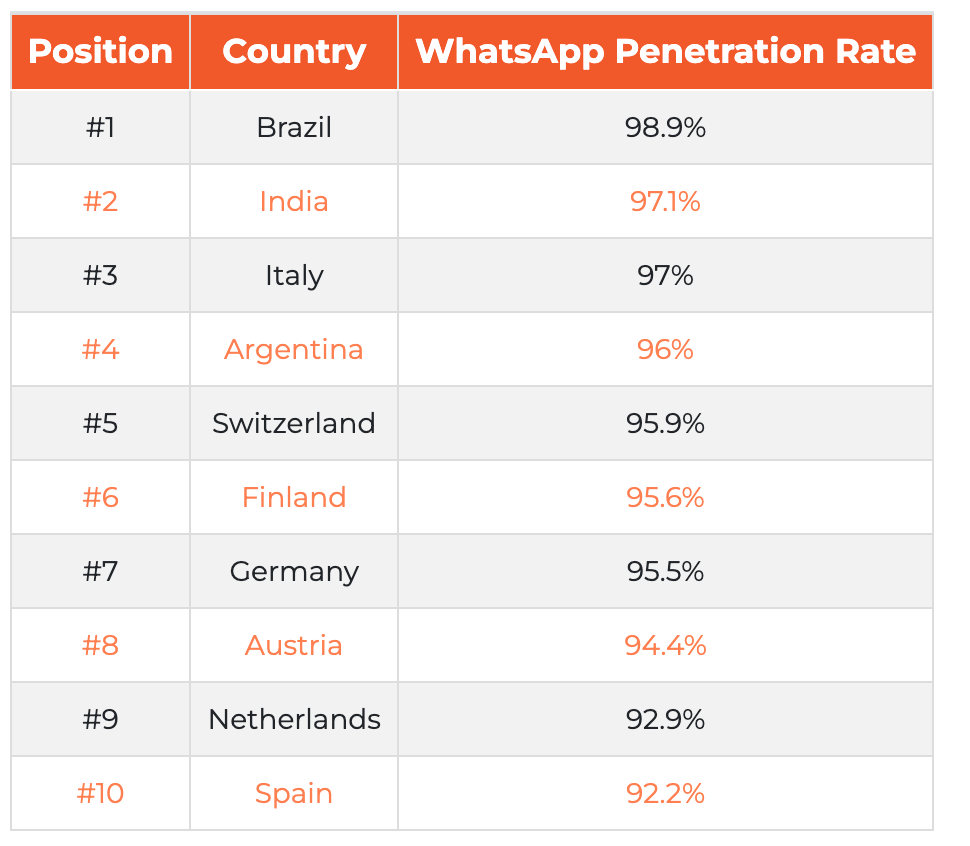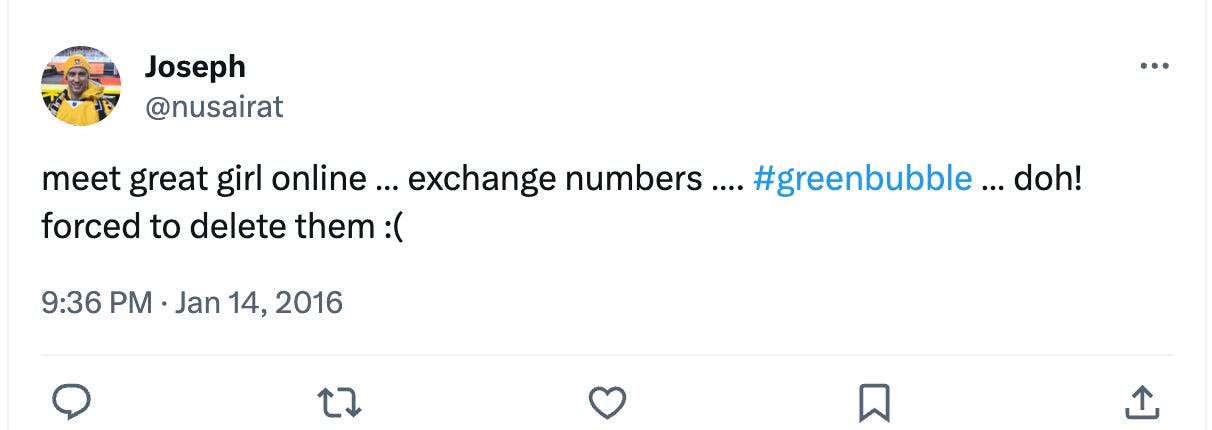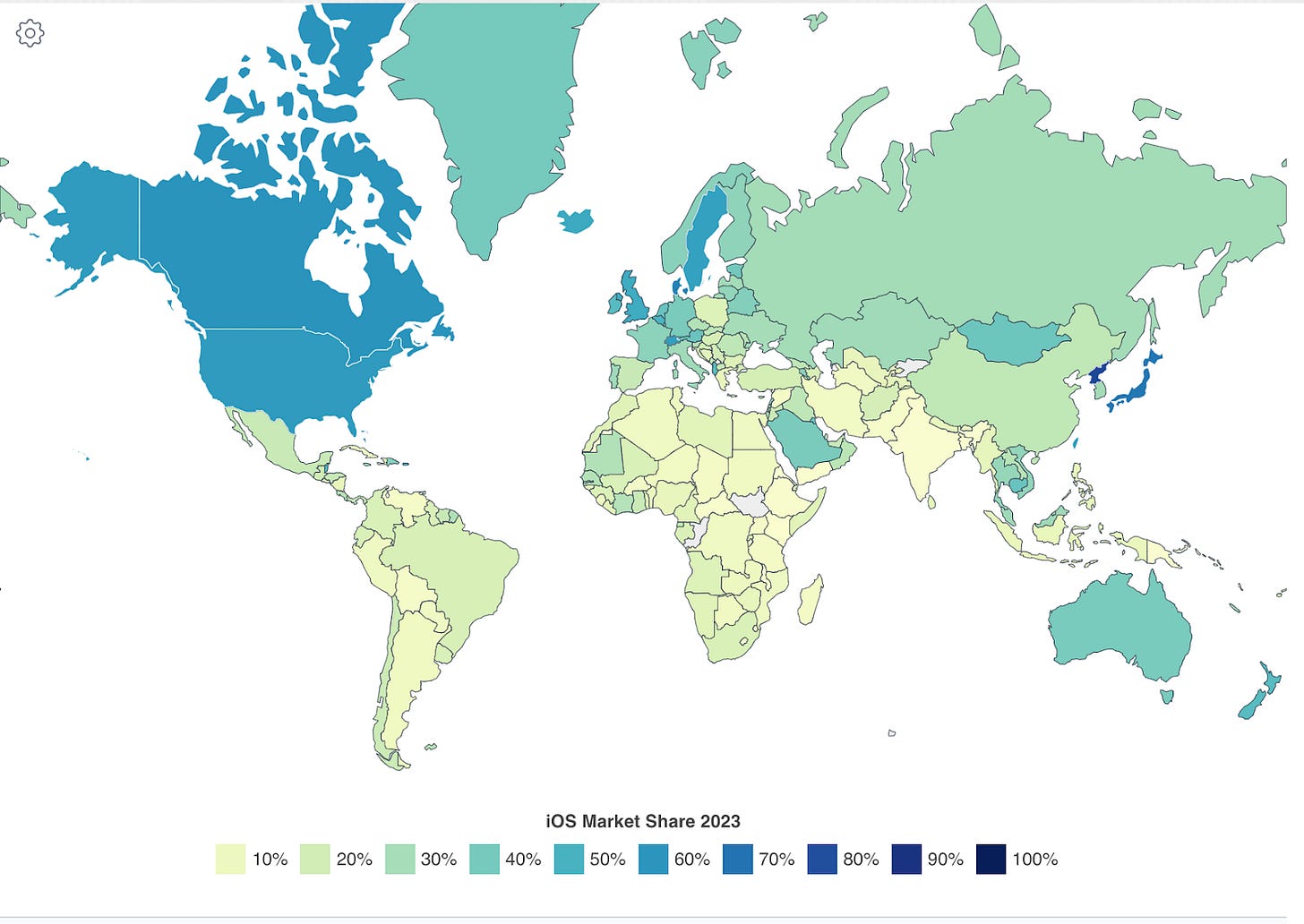I came late to the smartphone game. I finally bought my first in the fall of 2011, after spending a summer conducting research in India where, incidentally, I sit writing this. I didn't have any specific animus toward Apple at the time, though I do think I preferred the reputation of openness and customizability of Androids against that of iPhones as impenetrable, “take-what-we-give-you-and-you’re-gonna-like-it” systems.
I was also what we call “broke,” and wanted the cheapest functional phone I could find.
Over the following decade, I began to learn more about our culture that glorified iPhone and shunned Android. Even within Google, contrary to what many who've asked me think, employees are not mandated to use Android phones. (Though I do think this would lead to their rapid improvement.) It was actually funny to me how predictably designers, marketers, and others in “humanities-type” roles used iPhones, whereas the vast majority of engineers I worked with used Android. Make whatever stereotypical conclusions you want based on this observation, but I'll leave it at that.
Regardless, what I heard from those who used iPhones was that they were, without exception, better.
A Heretic Repents
Fast forward to 2020 when, hoping to install some excitement into the droning mundanity of pandemic life as much as anything else, I finally splurged on a new iPhone. I was excited to scope out the hype, to be swept off my feet with magic, to perhaps bend with regret over not having seen the light sooner.

But a few weeks after getting used to the phone I was… nonplussed. Even disappointed, if we're being honest. I found typing on iPhone to be much worse than on Android, which is important since I (don't we all?) spend a lot of my phone time typing — and I'm definitely not the only one who thinks this. Night photos seemed worse, and friends who’d tried both agreed. And I noticed various other degradations: Android seemed better at knowing when to auto-rotate photos of text, which I often take.
And I hate how when I'm using a streaming app while in airplane mode, even when I’ve offloaded content for it, a pop-up message will incessantly remind me… that I'm on airplane mode. Like, I know — I was the one who made the decision! (If you haven't noticed this, you will now. I’m sorry.)
And I missed how Android let me connect my alarm clock to Spotify to create custom wake-up songs, whereas iPhone won't do this without forcing users to pay: either to download a separate app, or to buy songs on Apple Music. I felt like I was being nickel-and-dimed just so I wouldn’t have to use the default iPhone alarms, which haven’t really changed from the default iPod ones we all used nearly twenty years ago.
Anyway, I’m not here to convince you to switch to Android. I don’t really care.
What I'm saying is that for me, for how I use a phone, I prefer Android. And that shouldn't really matter to anyone else. Our phones have become — for better and mostly worse — intimate companions. We spend more time with them, after all, than about anyone else.
Wouldn't it be weird for someone we barely know to judge and shame us for how we make other highly personal decisions? And yet that's what we have today — but only really in America, a point I'll get to soon.

I Want My Blue Bubble, Blue Bubble, Blue Bubble Ribs
It’s the bubbles, of course. When two iPhone users text over iMessage, the messages show up in a soothing blue color, meaning photos can be easily shared, group chats created, and fun emojis sent.
But god forbid there’s an Android on the text chain. Hatred of green bubbles in this country is so pervasive I didn’t even bother explaining this article’s headline: it crops up in memes, on podcasts, even dating app bios, and it’s a source of cyberbullying among kids and teens now, too.

When I finally started using an iPhone in 2020 I got messages from friends — some I’ve known since childhood — congratulating me on the switch. It felt like, wow, you’ve been judging me all this time?
If you’re an Android user in America thinking “No one I know judges me for using Android!”, well think again, Buster Brown. Your friends are probably too nice to say anything, or they’re all using Android too. (Hi, Bay Area.)
There’s nothing about SMS, the decades-old technology Apple phones rely on to communicate with Androids, that requires they show up as green. Apple could do nothing with them; they could make them a different shade of blue; they could keep them the same shade of blue, and add a little “S” to the bubble, or a star, or an icon of a whale, it doesn’t really matter. The choice to not extend blue bubbles to Android is most certainly a strategic one – you can bet Apple worked to find a green bubble color that’s irritating when its users text with Androids, but not so irritating they’ll rebel.
They continue with this old technology even when it creates security risks, which is a bold move for a company branded around protecting user privacy and security. Apple will finally support RCS this year, which will bring most modern iMessage-type features to Android chats, including greater security (or at least, it might.) They’re likely only doing this because the EU is forcing them though, and Android messages will still show up green anyway. Even if it doesn’t really matter anymore, and arguably it never really did.
The Bond villain brilliance in all this is that Apple has effectively deputized vast swaths of the American public to pressure their friends, family members, and even prospective romantic interests into using their products. When a journalist asked Tim Cook last fall if the company planned to make changes so his mother, who uses Android, could actually see the videos he sends her, Cook told the journalist to “buy your mom an iPhone.”
But again, all this bubble kerfuffle happens almost entirely in America, among Americans. Why?
Messaging Apps 💬 📟
In short, it’s because the vast majority of the world’s internet users stopped communicating via text years ago — if they ever did in the first place. They use WhatsApp, WeChat, Telegram, or Signal… or LINE, Kakao, Viber, or one of a dozen others. In fact, when I tell people outside the US that Americans don’t use WhatsApp, I’m usually met with a look of shock and the question, “What do you use, then?”

Americans, in fact, might be the only people who don’t regularly use WhatsApp, or something like it — the app has nearly 2.8 billion users (or ~57% of everyone using the mobile internet worldwide), but nevertheless the only Americans I know who use it travel often outside the country, or have foreign friends.
Even in iPhone-heavy countries like Japan and Taiwan — citizens of which primarily use LINE messenger — there’s surely cachet to owning an iPhone, and probably some social pressure to do so. AirDrop and FaceTime still only work from iPhone-to-iPhone, for one.
In fact, a young Indian woman working at my hotel tells me, as I write this, that among her friends there’s pressure to use iPhone for these reasons — but she’s also one of the people who asked, shocked, what we use to communicate in the US if we don’t use WhatsApp.
But even this level of social pressure doesn’t feel as extreme as it is in the US — FaceTime and AirDrop aren’t that commonly used, and you’re unlikely to be rejected from a first date before you’ve even met because of them.

Elon Musk tweeted a few years ago that people should use Signal instead of Facebook products. (Facebook acquired WhatsApp in 2014, for a staggering sum.) Signal is the preferred secure messaging app for those in the know, and its user numbers began skyrocketing shortly after the tweet — and funnily enough, so did the stock of Signal Advance, a completely unrelated company.
I joked with friends at the time that I wanted to send around a slide deck within Google recommending the company acquire Signal, or at least surreptitiously promote it like à la Musk. (I only joked and never actually did this because Google is probably the last sponsor that Signal — a messaging app with an entire raison d’etre of protecting user privacy and security — might want.) But more Americans using Signal would almost certainly make Google happy, because the green bubbles would lose their importance. And this would probably lead to Apple selling fewer phones.

So What?
Next time you’re chatting in your group chat of blue-bubble-only iPhone users and shaming the Android weirdo you left out, remember you’re experiencing a uniquely American problem. I would argue that to complain about it is even provincial, ignorant of the winds of change shaping how the rest of the world uses the internet. And furthering the ways in which America is just, well, weird.
As even New York Times recommends, why not “go beyond the default” texting apps and move a group chat to WhatsApp — or Signal, or literally any other messaging app out there? (On a fun, conspiratorial note, I know many iPhone users who dislike WhatsApp, and I myself have noticed the app works better on Android — is this only a coincidence, or an Apple trick to keep users on iMessage? 🤔🤔🤔)
Better yet, spread the word among your iPhone-using friends: green bubbles are there because Apple wants them there. As they say, don’t hate the player, hate the game.
Song of the Week: FKA Twigs, Headie One, Fred Again.. — Don’t Judge Me








In all fairness both companies have monopolistic policies in place. I chose Apple for their better policies on privacy. Hard choice to be sure but neither is a very good ones at this point.